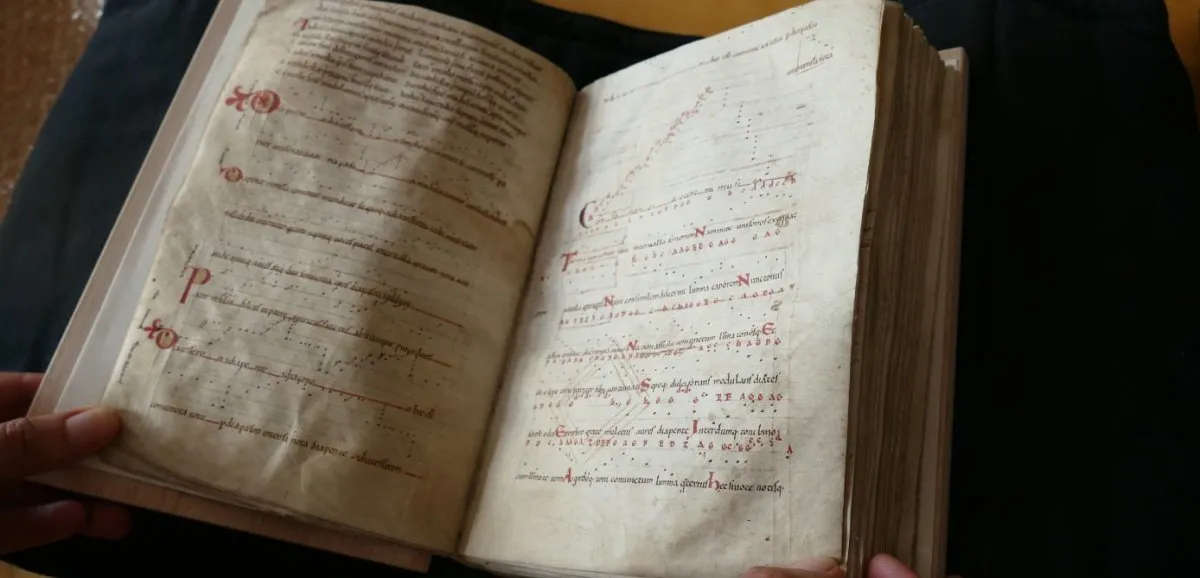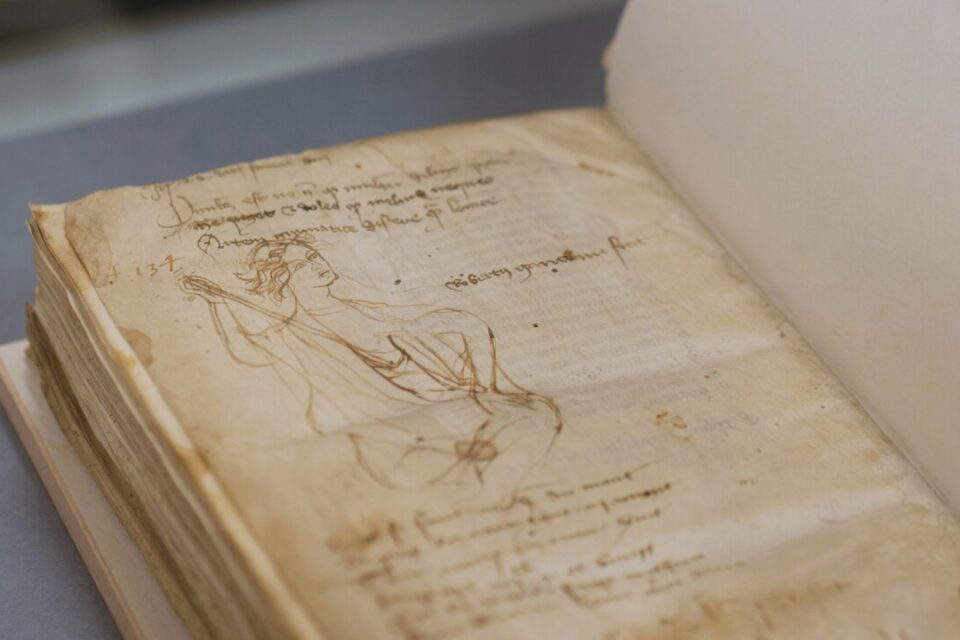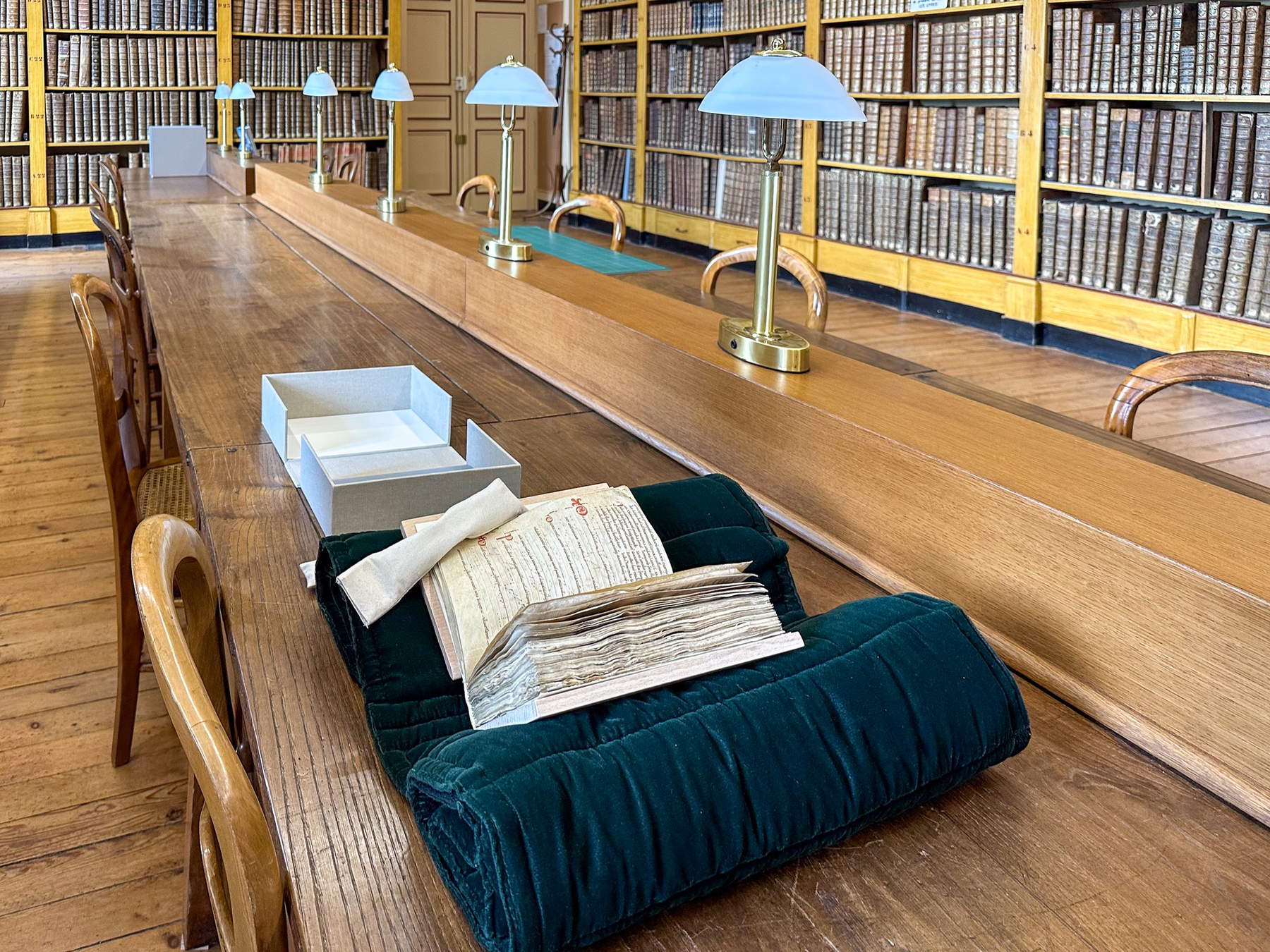A medieval manuscript from the prestigious monastic library of Mont Saint-Michel, one of the most important of its time in France, was recently rediscovered after more than two hundred years of absence. The return to the French national collections represents a significant event in terms of historical and cultural heritage. The manuscript was formally returned to the state in 2023, and on June 27 it was handed over to the city of Avranches, the official repository of the Mont Saint-Michel manuscripts since the French Revolution. The transfer took place in Caen, where Nicolas Georges, director in charge of books and reading at the Ministry of Culture, officially handed over the manuscript to the mayor of Avranches, David Nicolas. As of July 5 and until next October 11, the volume is on display at the Scriptorial Museum in Avranches.
The discovery of the manuscript is the result of a long and complex process that began in 2018 in Alençon, when a medieval manuscript was spotted in an auction catalog. Although it is not uncommon to come across similar texts in this kind of context, the work quickly attracted the attention of scholars. Some specific elements (decorations, subjects, type of writing, and the presence of an archival marking) suggested an origin related to the abbey of Mont Saint-Michel. Even more significant evidence was one of the liturgical prose contained in the manuscript, dedicated to Saint Oberto, bishop of Avranches and founder of the abbey of Mont Saint-Michel.
Under the impetus of a group of researchers, a detailed investigation began, which involved analyzing historical inventories and reviewing the history of manuscripts in the monastic library. Comparison with ancient documents allowed a formal identification of the manuscript as part of the medieval collection of Mont Saint-Michel, dating between the 12th and 13th centuries. The last certain mention of the manuscript was in the early 19th century. This is the first case of the reappearance of a Mont Saint-Michel manuscript in more than 150 years.

As a national asset, the manuscript was claimed by the French state. The Ministry of Culture, after obtaining recognition of public ownership by the Paris Administrative Court in June 2020, obtained its return in April 2023. The work subsequently underwent restoration and digitization before being entrusted to the city of Avranches, where it is now preserved along with two hundred other Mont Saint-Michel manuscripts.
The volume is a composite work, bringing together four separate, originally independent manuscripts, united by their educational function. The first section is devoted to the teaching of music, through medieval didactic treatises. It is followed by a liturgical composition in prose and verse, dedicated to Saint Oberto. This text is the oldest known witness to a poetic composition that was already known in later manuscripts dating back to the mid-17th century. The liturgy was performed during Mass and established a parallel between musical harmony, divine harmony and human virtues, in a context reflecting the monastic ideal of the time.
The second part contains an initial allegorical tale by Jean d’Hauville, entitled Architrenius, which features the “master of laments,” a character oppressed by life’s difficulties and seeking consolation from Mother Nature. Immediately afterwards we encounter a second tale, attributed to Alain de Lille, also philosophical and poetic in character, focusing on the theme of learning through an initiatory path. Particularly enigmatic is the drawing on the last page of the manuscript, which depicts a human figure seated cross-legged, dressed in the old-fashioned manner, holding a staff or perhaps the handle of a musical instrument. It is unclear whether this is a depiction of the archangel Michael or an unfinished musician. Next to the drawing, a handwritten inscription leaves room for interpretation. It reads a note in Latin, probably penned by a monk or a reader: “It is a well-known thing that I love drinking very much. / It pains me that I cannot learn the art of grammar better than the art of logic.”


The texts dating from the 12th century were most likely copied within the scriptorium of Mont Saint-Michel Abbey, while those from the 13th century may have come from Parisian university circles, intended for teaching. According to some speculation, it is possible that they were brought to the abbey by students who later entered monastic life. The volume was accurately described in several catalogs between the 17th and 18th centuries and remained in the Mont library until the end of the 18th century, only to disappear sometime between 1795 and 1801, thus at the time of the French Revolution.
The monastic library of Mont Saint-Michel, developed from the late 10th century with the arrival of the Benedictines in 966, was for centuries one of the most important centers of knowledge production and preservation. Between the 11th and 13th centuries, its scriptorium experienced a particularly fertile season and contributed to the production of works of great value, in the context of an abbey that, at the time, represented a fundamental node in European culture.

After the French Revolution, in 1791, the property of religious communities was confiscated by the state by decision of the revolutionary authorities and declared national property. The city of Avranches received a significant part of the book heritage of the abbeys in the region, including the collection of Mont Saint-Michel Abbey. Since then, the city has been involved in the preservation and enhancement of these manuscripts: they are kept in the city’s heritage library and presented to the public through rotating exhibitions at the Scriptorial Museum, the only museum in France devoted exclusively to the manuscripts of Mont Saint-Michel Abbey. A specific room, called the “treasure room,” is reserved for their display.
The recently found manuscript had already been recorded in the first inventory of 1795, compiled in Avranches during the revolutionary phase by Pierre François Pinot-Cocherie, when the manuscripts had just been transferred from the Mont library. However, it is no longer mentioned in the subsequent inventory of 1834, edited by Monsieur Castillon de Saint-Victor. This documentary vacuum has fueled doubts and questions about its fate for more than two centuries.
Currently, about two hundred Mont Saint-Michel manuscripts are preserved in Avranches. About twenty, however, are found distributed in libraries and museums in other cities, including Paris, London, Rome and New York. The return of this volume represents a rare opportunity to enrich Mont Saint-Michel’s documentary holdings and offers the public an opportunity to rediscover a significant part of Europe’s cultural heritage.
 |
| Mont Saint-Michel manuscript that disappeared during the French Revolution resurfaces after two centuries |
Warning: the translation into English of the original Italian article was created using automatic tools. We undertake to review all articles, but we do not guarantee the total absence of inaccuracies in the translation due to the program. You can find the original by clicking on the ITA button. If you find any mistake,please contact us.